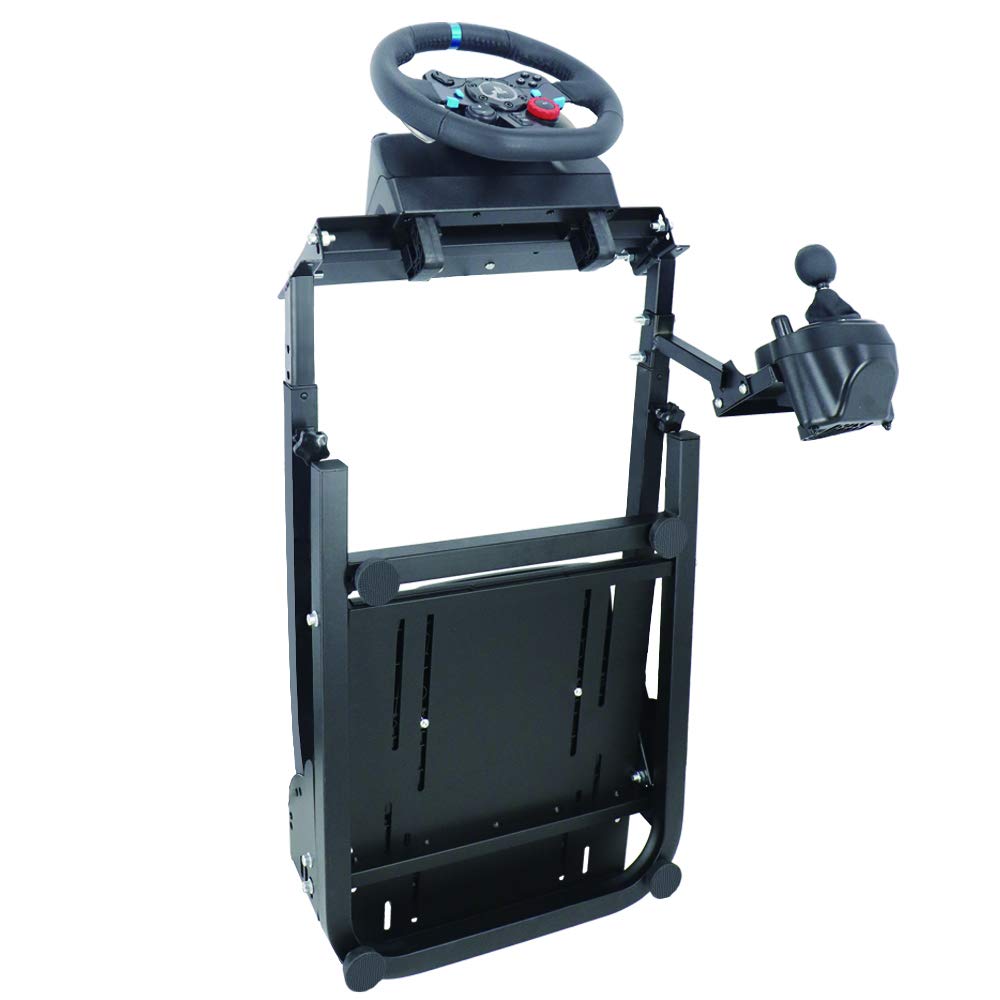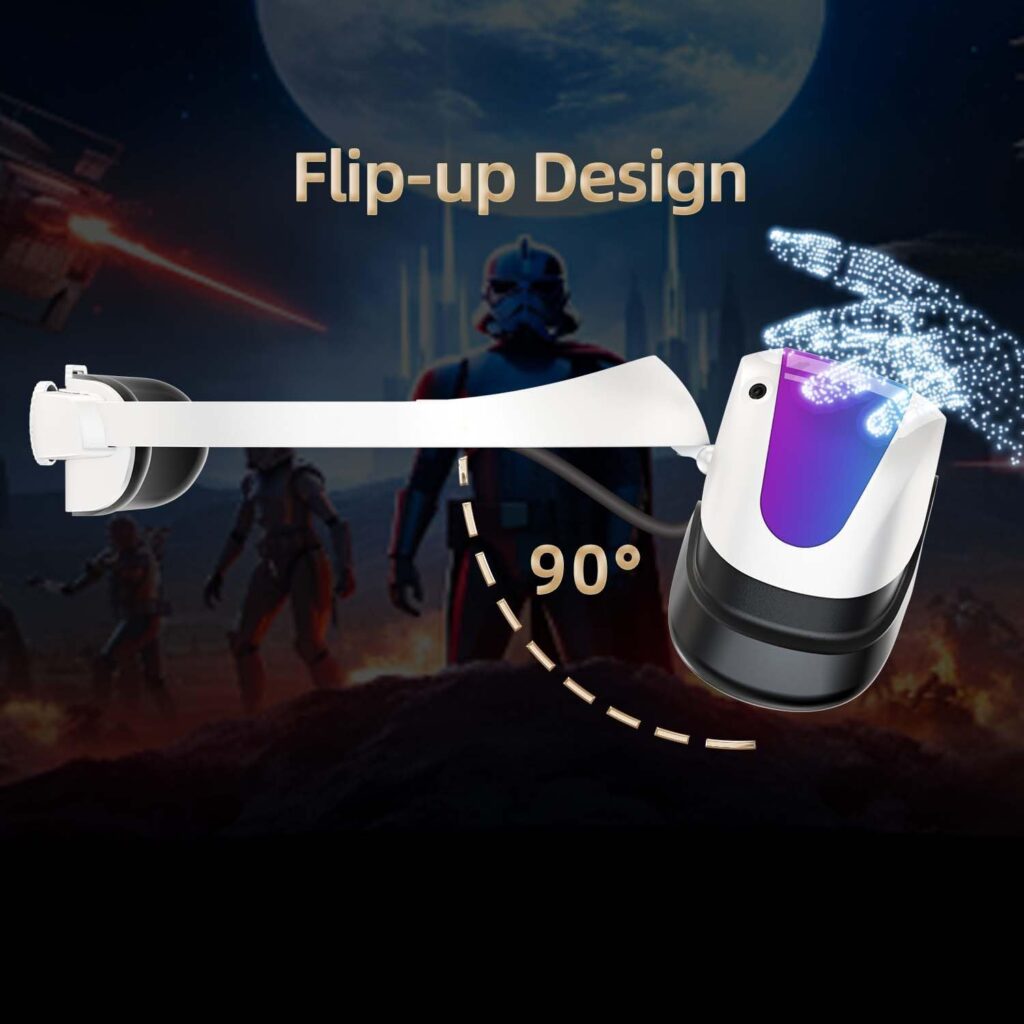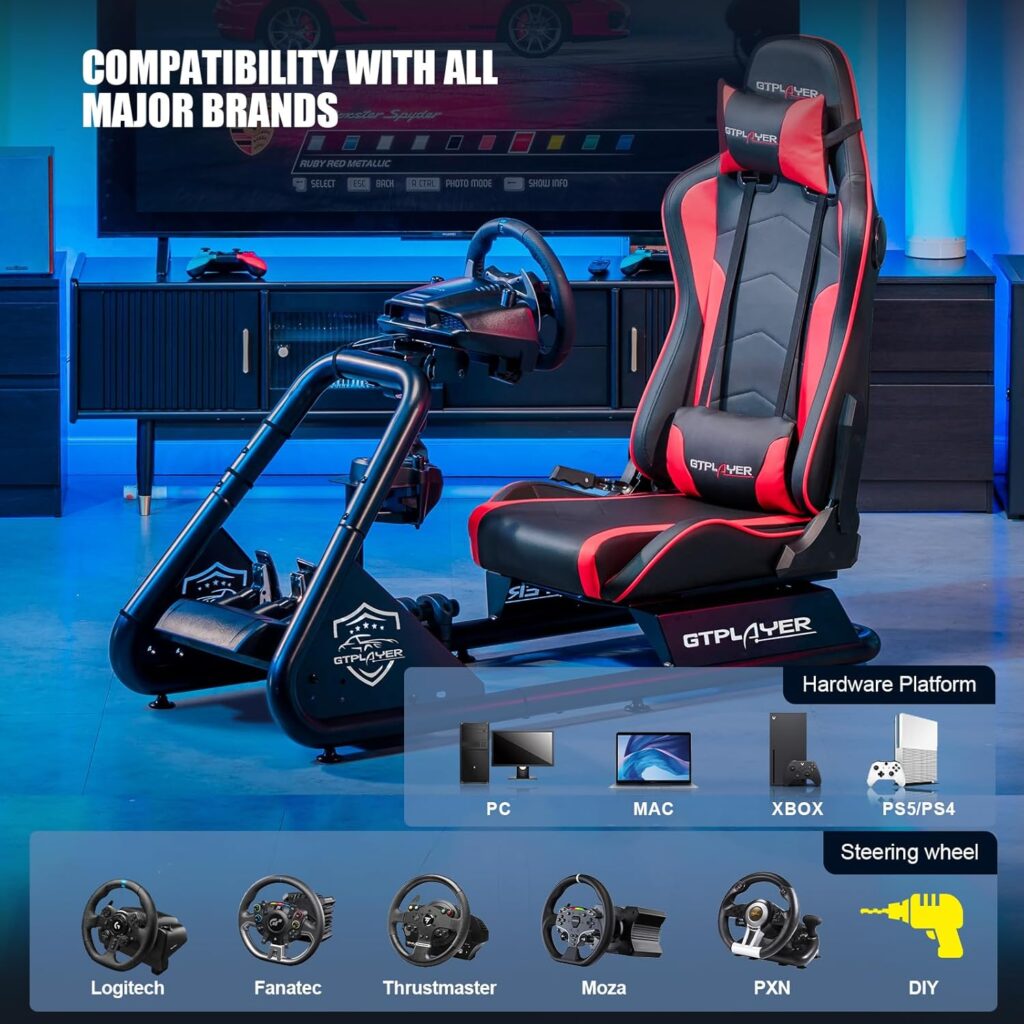Are you aware that understanding the physics behind sim racing can significantly improve your performance on the virtual track? With every turn, every acceleration, and every brake, your car's dynamics come into play, affecting your lap times and overall racing strategies.
But how exactly do weight transfer, tire grip, and aerodynamics influence your car's behavior? In this discussion, we will delve into the intricate world of sim racing physics, exploring the fundamental elements that govern the dynamics of your car.
By the end, you'll have a deeper understanding of these concepts, empowering you to optimize your racing skills and challenge your competitors on a whole new level.
Key Takeaways
- Tire grip and weight transfer play a crucial role in managing traction, control, and stability in sim racing.
- Understanding and applying Newton's laws of motion can enhance the realism and accuracy of vehicle dynamics simulations.
- Proper braking techniques and control inputs like throttle and brake management help maximize grip and prevent oversteer or wheel lock-up.
- Aerodynamics significantly impact cornering dynamics, and optimizing the design of the car's body and wings can improve traction and stability.
The Role of Tire Grip
Understanding the role of tire grip is essential for optimizing a car's performance and maximizing traction while driving. Tires are the only point of contact between the car and the road, making their grip crucial for transmitting driver commands and maintaining traction. The grip of a tire can be allocated to three directional forces: acceleration, deceleration, and turning.
When it comes to cornering, the effectiveness of a tire's contact patch is determined by its slip angle. Maximizing available traction requires optimizing the slip angle. It's important to note that load transfer plays a significant role in managing grip. Factors such as driver inputs, changes in track surface, and aerodynamics influence load transfer.
Proper use of techniques like trail braking and throttle control is crucial for maintaining grip and control. By understanding the dynamics of tire grip, drivers can effectively apply vehicle dynamics principles to enhance performance and lap times.
Therefore, a thorough understanding of tire grip is essential for maximizing a car's potential and ensuring a safe and enjoyable driving experience.
Understanding Weight Transfer
Weight transfer is a fundamental aspect of car dynamics that significantly influences the handling characteristics and performance of a vehicle. Understanding how weight is transferred during different driving situations is crucial for optimizing vehicle performance and improving driving techniques.
Here are three key points to help you grasp the concept of weight transfer:
- Weight transfer happens: When you accelerate, brake, or corner, the weight of the car shifts from the front to the rear or vice versa. During acceleration, weight transfers to the rear, increasing traction on the rear tires. When braking, weight transfers to the front, increasing traction on the front tires. During cornering, weight transfers to the outside tires, improving grip and stability.
- Front tires bear the force: As weight transfers, the force applied to the tires changes. During acceleration, the force on the rear tires increases, allowing for better traction. Conversely, during braking and cornering, the force on the front tires increases, improving grip and control.
- Balancing front and rear weight: The distribution of weight between the front and rear of the car affects how it handles. Proper weight distribution allows for better control and stability. Factors such as center of gravity location, corner weights, and acceleration impact weight transfer, so optimizing these factors is essential for achieving an ideal balance.
Newton's Laws and Their Application
Now it's time to apply Newton's laws to the dynamics of racing cars.
By understanding and applying these laws, you can gain insights into how weight transfers during acceleration, braking, and cornering.
This knowledge allows you to analyze the forces acting on the car and make informed decisions on driving techniques and setup adjustments.
Newton's laws provide a scientific framework for optimizing vehicle performance and enhancing your understanding of car dynamics.
Applying Newton's Laws
To accurately simulate car dynamics in sim racing, it's crucial to apply Newton's Laws and understand their practical application.
Newton's first law states that an object will remain at rest or in uniform motion unless acted upon by an external force. In sim racing, this law is essential for understanding how weight transfer affects the car's behavior during acceleration, braking, and cornering.
Newton's second law, which states that force equals mass times acceleration, helps in calculating weight transfer and the resulting forces on the tires. This knowledge is crucial for accurately modeling tire contact and force feedback in sim racing.
Understanding the practical application of Newton's Laws allows for a more realistic simulation of vehicle dynamics, enhancing the overall experience for sim racers.
Car Dynamics Explained
Understanding the practical application of Newton's Laws in sim racing is crucial for accurately modeling car dynamics and enhancing the overall experience for sim racers. Newton's laws explain the dynamics of racing cars, including weight transfer during acceleration, braking, and cornering. By applying these laws, you can better understand the forces acting on your car and how they affect its behavior on the track.
One important point to consider is the concept of weight transfer. When you accelerate, brake, or turn, the weight of the car shifts from one point to another. This transfer of weight affects the traction and grip of the tires, which in turn influences the car's ability to accelerate, brake, and corner effectively.
To emphasize this point, let's take a look at a table that illustrates the forces involved in different scenarios:
| Scenario | Forces Acting On The Car |
|---|---|
| Acceleration | Forward |
| Braking | Rearward |
| Cornering | Lateral |
Another factor to consider is the influence of control inputs, such as steering, throttle, and braking. Properly manipulating these inputs can help you manage weight transfer and maximize grip. For example, trail braking is a technique where you continue to brake as you enter a corner, which shifts weight to the front tires and helps reduce understeer.
Braking Techniques for Maximum Performance
For maximum performance in braking, it's crucial to grasp the dynamics of weight transfer and effectively utilize braking techniques to optimize your vehicle's performance. Understanding the intricacies of braking can significantly enhance your sim racing experience.
Here are three key braking techniques to achieve maximum performance:
- Trail braking: This technique involves a controlled compromise between turning and braking. By maintaining a slight brake pressure while entering a corner, you can shift the weight to the front wheels, optimizing grip and enhancing braking performance. Trail braking also helps rotate the car and obtain the optimum slip angle early in the turning event.
- Traction management: Understanding the importance of traction and tire grip is vital for effective braking. By modulating the brake pedal with precision, you can maximize the available grip, preventing wheel lock-up and maintaining control. Proper traction management ensures efficient deceleration and minimizes the risk of skidding or sliding.
- Throttle and brake control: Trailing Throttle Oversteer (TTO) can occur when lifting off the throttle during load transfer. To improve braking performance, it's essential to manage TTO by properly controlling the throttle and brake inputs. Smoothly transitioning between these inputs helps maintain stability and optimize braking efficiency.
Mastering Cornering Dynamics
Mastering cornering dynamics requires a deep understanding of the intricate interplay between weight transfer, aerodynamics, tire modeling, and control inputs. In sim racing, cornering dynamics play a crucial role in achieving optimal performance and maintaining control of your vehicle.
When cornering, weight transfer shifts from the inside wheels to the outside wheels, affecting traction and balance. This transfer of weight is influenced by various factors, including corner weights, track width, center of gravity location, and acceleration.
Additionally, aerodynamics significantly impact cornering dynamics. The forces acting on the vehicle, such as lift and drag, as well as the distribution of these forces, can greatly affect the handling characteristics during cornering.
Proper tire modeling is also essential for accurate vehicle dynamics simulations. Different tire models represent tire behavior and characteristics, including grip, sidewall flex, and tire deformation.
Finally, control inputs, such as throttle, brake, and steering, are crucial for managing acceleration, deceleration, and direction during cornering. Understanding the importance of traction, balancing the car, and applying vehicle dynamics principles is key to mastering cornering dynamics in sim racing.
The Impact of Aerodynamics on Your Car
Aerodynamic forces play a crucial role in determining your car's performance on the race track. Understanding the effects of drag and lift is essential for optimizing your lap times.
Aerodynamic Forces Explained
Understanding the impact of aerodynamics on your car is crucial for predicting its behavior during acceleration, braking, and cornering. Aerodynamic forces play a significant role in determining how your car performs on the track. Here are three key points to consider:
- Lift forces: Aerodynamics can generate lift forces, which act in an upward direction and reduce the weight on your rear tires. This can result in reduced traction and stability, making it harder to control your car.
- Downward force: By optimizing the design of your car's body and wings, you can generate a downward force known as downforce. This force pushes your car towards the ground, increasing traction and improving cornering capabilities.
- Forces acting on the rear tires: The aerodynamic forces acting on your car affect the weight distribution between the front and rear tires. By manipulating these forces, engineers can increase the load on the rear tires, allowing for higher accelerations without increasing the overall weight of the car.
Understanding these aerodynamic forces will help you fine-tune your car's setup and maximize its performance on the virtual track.
Effects of Drag and Lift
To optimize your car's performance, it's essential to comprehend the impact of drag and lift on its aerodynamics.
Drag is the force acting against the vehicle's direction of motion, caused by air resistance. It's influenced by factors such as vehicle velocity, airfoil design, and body shape.
On the other hand, lift is an upward force that can be produced due to the pressure difference between the top and bottom surfaces of the car. Understanding these aerodynamic forces is crucial as they directly affect the vehicle's acceleration, braking, and cornering abilities.
The laws of physics, including Earth's gravity, play a significant role in determining the magnitude of drag and lift. Additionally, the track surface and external conditions can also impact these forces.
Improving Lap Times
Can aerodynamic modifications enhance your car's lap times? Absolutely! Understanding the physics of vehicle aerodynamics in a racing simulation can have a significant impact on improving lap times. Here's how:
- Reducing drag: By optimizing the shape of your car, you can minimize drag and increase straight-line speed, allowing for faster acceleration and higher top speeds.
- Generating downforce: Properly designed wings and spoilers can generate downforce, which increases the tire's contact patch with the road. This improves grip and stability, reducing understeer and oversteer and allowing for more precise cornering.
- Managing airflow: By directing airflow around and over the car, you can control lift and maintain stability. This helps keep the car planted to the ground, allowing for better control and improved lap times.
Suspension Setup for a Balanced Ride
Achieving a balanced ride requires careful attention to suspension setup, as it directly impacts weight transfer and ultimately influences the performance and control of the vehicle during acceleration, braking, and cornering. The suspension system plays a crucial role in maintaining the dynamic equilibrium of the car, ensuring that the weight is distributed optimally across all four tires. By making precise adjustments to the suspension setup, you can enhance tire grip and traction, maximizing the vehicle's potential on the racing track.
A well-balanced suspension setup promotes stability and control during high-speed maneuvers, allowing you to navigate corners with confidence and precision. It helps to minimize body roll, keeping the car stable and planted on the road surface. By addressing understeer and oversteer issues through suspension adjustments, you can fine-tune the car's handling characteristics and improve its responsiveness to driver inputs.
Understanding the principles of suspension setup is essential for achieving a balanced ride. Factors such as spring rates, shock absorber settings, ride height, and anti-roll bar stiffness all contribute to the overall behavior of the car. Properly adjusting these parameters can help optimize weight distribution, reduce unwanted weight transfer, and improve the overall performance of the vehicle.
Tuning Your Car for Different Track Conditions
Adjusting your car's setup to suit different track conditions is crucial for optimizing performance and maintaining control on the racing circuit. Teams rely on various adjustments to ensure their cars are well-suited to the specific demands of each track.
Here are three key areas to consider when tuning your car for different track conditions:
- Suspension Adjustments: By modifying spring rates and anti-roll bars, you can optimize weight distribution under acceleration and cornering. This allows your car to better handle the forces exerted on it during high-speed maneuvers, ensuring stability and control.
- Aerodynamic Tweaks: Varying track conditions may require adjustments to wing angles and body shape to maximize downforce and minimize drag. These changes enhance your car's overall performance by improving grip and stability, allowing you to navigate the track with precision.
- Tire Pressure and Compound: Adjusting tire pressure and compound is essential for optimizing grip and traction. By finding the right balance, you can ensure better handling and stability, enabling you to tackle corners and straights with confidence.
Keep in mind that even small adjustments in these areas can make a significant difference in lap times. Take the time to analyze track conditions and make the necessary changes to your car's setup. By doing so, you'll be better equipped to tackle the challenges of each circuit and achieve optimal performance.
Exploring the Effects of Vehicle Mass
When considering the impact of vehicle mass on car dynamics, it's essential to understand how weight transfer affects tire grip and overall handling performance. Vehicle mass influences the distribution of forces on the tires, which directly affects the grip and traction available to the driver. Heavier vehicles experience more significant weight transfer during acceleration, braking, and cornering, which can have a profound impact on their handling capabilities.
During maximum acceleration, a heavier vehicle will transfer much load to the rear tires, increasing the grip and allowing for greater traction. This results in improved acceleration performance. Conversely, during maximum braking, the weight transfer shifts towards the front tires, increasing their grip and allowing for more effective deceleration.
When navigating corners, the distribution of weight transfers to the outside tires, affecting their grip and the vehicle's ability to maintain traction. The slip angle, which is the difference between the direction the tires are pointing and the direction the vehicle is moving, plays a crucial role in determining the forces on the tires. A heavier vehicle will experience more load transfer, resulting in increased grip on the outside tires and reducing the likelihood of understeer.
Advanced Techniques for Fine-tuning Your Car's Dynamics
To fine-tune your car's dynamics, employ advanced techniques that optimize vehicle behavior and enhance performance. These techniques involve a deep understanding of the various factors that influence vehicle dynamics and the ability to make precise adjustments.
Here are three advanced techniques for fine-tuning your car's dynamics:
- Steady-state Weight Transfer (SSWT) calculations: Understanding the distribution of weight during different driving conditions is crucial for optimizing vehicle behavior. By calculating the steady-state weight transfer, you can adjust suspension settings and balance the car's weight distribution to improve stability and cornering performance.
- Aerodynamics optimization: Aerodynamics play a significant role in how a car behaves during acceleration, braking, and cornering. By fine-tuning the aerodynamic elements such as spoilers, diffusers, and wings, you can enhance grip, reduce drag, and increase downforce, resulting in improved overall performance.
- Accurate tire modeling: The tires are the only contact point between the car and the road, making them a critical component in vehicle dynamics. By accurately modeling the tire behavior, including factors like tire grip, slip angles, and temperature, you can make informed adjustments to optimize traction, handling, and braking performance.
Frequently Asked Questions
What Is Vehicle Dynamics Simulation?
Vehicle dynamics simulation is a real-time simulation that allows you to understand how your car handles in various situations. It models the complex interactions between your vehicle and its environment, taking into account factors like tire dynamics, suspension geometry, and aerodynamics.
What Sim Racing Game Has the Best Physics?
If you want the most realistic driving experience in sim racing, pay attention to the physics. The choice of physics engine can make or break your gameplay.
Some games excel in replicating the dynamics of real cars, like iRacing with its accurate tire model and force feedback.
Others, like Assetto Corsa Competizione, focus on GT3 car physics and advanced aerodynamics.
rFactor 2 offers dynamic track evolution and realistic force feedback, while Automobilista 2 impresses with comprehensive vehicle dynamics and advanced tire simulation.
What Is Dynamics in Cars?
Car handling is the way your vehicle responds to your inputs and the road conditions. It's influenced by several factors, including tire grip, suspension setup, aerodynamics effects, and weight distribution.
Tire grip determines how well your tires grip the road, affecting your car's ability to accelerate, brake, and turn.
Suspension setup plays a role in how your car rides and handles bumps and corners.
Aerodynamics effects influence the airflow around your car, affecting its stability and performance.
Lastly, weight distribution affects how weight is distributed across your car, impacting its balance and handling.
What Is the Dynamics of a Car Motion?
Car motion is a complex interplay of forces acting on your vehicle. To understand its dynamics, you need to consider weight transfer, aerodynamics, tire models, and control inputs.
Weight transfer refers to how your car's mass redistributes during acceleration, braking, and cornering.
Aerodynamics play a crucial role in determining the distribution of forces on your vehicle, affecting lift and drag.
Tire models help explain how grip, slip angle, and slip ratio impact your vehicle's handling.
Control inputs, like throttle, brakes, and steering, dictate acceleration, deceleration, and direction in cornering dynamics.
Conclusion
Now that you have delved into the intricacies of sim racing physics and gained a deeper understanding of your car's dynamics, you're equipped with the knowledge to elevate your performance on the virtual track.
By mastering the art of weight transfer, tire grip, braking techniques, cornering dynamics, suspension setup, and car tuning, you can optimize your lap times and conquer different track conditions with finesse.
Remember, practice makes perfect, so hit the virtual road and let your newfound expertise shine through.




